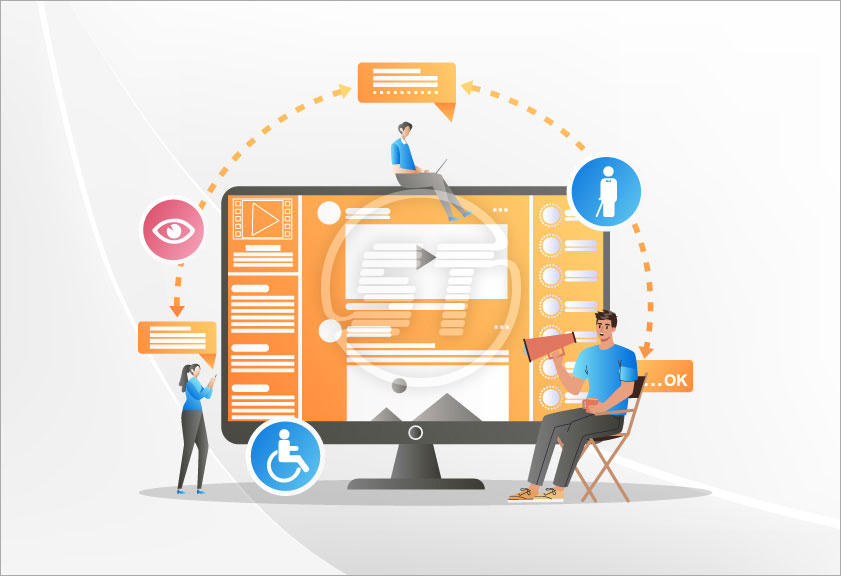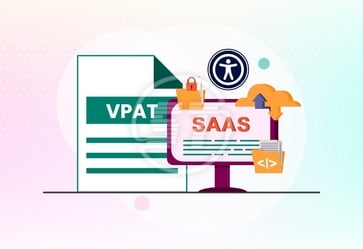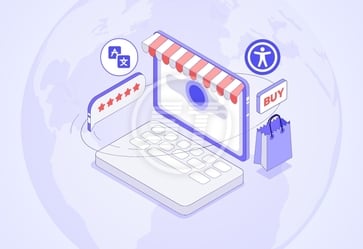Digital assets need to have multimedia content – videos, animations, podcasts, and interactive graphics – to register high online engagement. However, without accessibility, this multimedia content remains out of reach for millions of individuals with disabilities. And thus, ensuring that multimedia is inclusive is the need of the hour for businesses.
Accessible multimedia is a strategic advantage that broadens an organization’s audience base by enhancing the user experience for everyone. This article discusses multimedia content accessibility in detail; read to the end to get complete insights.
Multimedia accessibility makes a huge difference to a successful business!
Multimedia accessibility is the practice of making audio, video, and other dynamic media content usable for people with disabilities, including individuals with visual, hearing, cognitive, and motor impairments.
Reasons why it is crucial:
- Human rights and inclusion: Digital accessibility is a matter of equity and civil rights. According to the WHO, over 1.3 billion people live with some form of disability across the world. When multimedia is inaccessible, it refrains a massive global population from digital content access.
- Legal compliance: Laws such as the Americans with Disabilities Act (ADA), Section 508 in the U.S., and the European Accessibility Act (EAA) mandate accessible digital content. Non-compliance can lead to lawsuits, reputational damage, and financial penalties.
- SEO benefits: Search engine index transcripts and captions improve content discoverability. It also demonstrates organization’s commitment to diversity, equity, and inclusion (DEI).
- Wider audience reach: Accessible multimedia content can be used in varied environments – noisy, quiet, or with poor internet connectivity – offering a seamless user experience.
Central tenets of accessible multimedia
To make website multimedia content accessible, focus on these four fundamental principles of WCAG:
- Perceivable: For users having visual or hearing issues – provide captions, transcripts, and audio descriptions.
- Operable: Some of the users may face issues navigating and controlling the media – offer keyboard-accessible controls and allow users to pause, rewind, or skip content.
- Understandable: Content may not be clear and readable for many – use plain language, audio cues, and visual clarity to improve comprehension.
- Robust: Website content might not work alike across different technologies – ensure compatibility with latest screen readers, braille displays, and voice recognition tools.
Accessible formats for different media types: Must know!
- Video Content
Must-have features:
- Captions: Synchronized, accurate text of spoken words and sounds.
- Audio descriptions: Narration describing visual elements for blind users.
- Transcripts: Full-text versions of the dialogue and sound cues.
Additional points to note:
- High-contrast visuals are suggested to use.
- If possible, avoid flashing elements that can trigger seizures.
- Audio Content (Podcasts, Voiceovers)
Must-have features:
- Transcripts: Provide a verbatim written version of the audio.
- Clear narration: Use slow, well-articulated speech with minimal background noise.
- Offer summaries for longer recordings.
- Use descriptive titles and metadata for navigation.
- Interactive media and animations
Must-have features:
- Keyboard navigation
- Screen reader compatibility
- Alternative text for images and interactive elements.
Additional points:
- Provide important instructions for users before and during interaction.
- Ensure timing controls so users aren’t rushed.
Some of the best tools/platforms to ensure a frictionless multimedia experience!
The future of multimedia is immersive, dynamic, and data rich. But it also ought to be accessible. Latest technologies like AI-generated captions, natural language processing, and real-time translation are evolving to support even greater accessibility. However, technology should complement, not replace, human insights.
By embedding accessibility into every stage of multimedia production, organizations create experiences that are usable, meaningful, and enjoyable for everyone.
Tools:
Captioning and transcription
- Otter.ai: Real-time transcription and summaries
- Descript: Edit audio by editing the transcript
- Rev.com: Human-generated captions and subtitles
Media players
- Able player: Fully accessible open-source video/audio player
- YouTube’s player: Offers basic accessibility features (customizable captions, keyboard control)
Testing and validation
- Free Website Accessibility Checker
- WAVE by WebAIM
- Axe DevTools
- NVDA (screen reader for Windows)
- VoiceOver (built into macOS and iOS)
Quick accessibility checklist for multimedia
| Feature | Required for | Description |
|---|---|---|
| Captions | Videos | Text representation of spoken content and sounds |
| Audio descriptions | Videos | Narration describing visual elements. |
| Transcripts | Audio/Video | Full-text versions of dialogue and sound |
| Keyboard access | Interactive media | All controls must be keyboard operable. |
| Screen reader compatibility | All media | Proper HTML, ARIA labels, and structure |
| Clear visual design | All media | High contrast, legible fonts, minimal distractions |
Creating an inclusive production workflow
Avoid to “retrofit” accessibility; instead:
- Begin with accessibility in mind and include appropriate practices in the planning phase only.
- Record high-quality audio, pick readable typefaces, and do not use cluttered visuals.
- Collaborate with experts (WCAG accessibility consultants) to ensure content quality.
- Test early and often by using both automated tools and manual testing techniques.
Moreover, avoid some common pitfalls:
- Relying solely on auto-captions
- Using non-descriptive file names or buttons like “Click here”.
- Embedding videos without providing alternative formats.
- Designing complex interactions that can’t be navigated without a mouse.
Also read: Digital Accessibility Consulting Firm
Accessibility is nothing but a good design!
Accessible multimedia content isn’t just a feature – it’s a boon for businesses!
It transforms the viewing and listening experience for people with disabilities and uplifts usability for everyone. Embracing multimedia accessibility is a smart and cutting-edge move for businesses. Because accessible content is the only way to reach out to the target audience and succeed.
At Skynet Technologies, we believe accessibility belongs at the heart of every digital experience. Explore our comprehensive guide to multimedia content accessibility and uncover ways to break down digital barriers. From captions to alt text and accessible video players — make your content welcoming to all. Start creating a more inclusive digital world with us! We audit website for required ADA standards, prepare an action plan, and remediate website as per standard guidelines. On request, we can expediate website remediation for the clients having ADA website lawsuits. Reach out hello@skynettechnologies.com for more information or request a website accessibility remediation quote!


